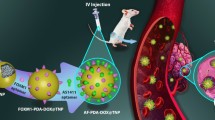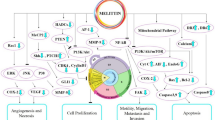Abstract
Purpose
This work focused on the characterization and in vitro/in vivo evaluation of an alginate/chitosan microsphere (ACMS) formulation of glucose oxidase (GOX) for the locoregional delivery of reactive oxygen species for the treatment of solid tumors.
Methods
The GOX distribution and ACMS composition were determined by confocal laser scanning microscopy and X-ray photoelectron spectroscopy. The mechanism of GOX loading and GOX-polymer interactions were examined with Fourier transform infrared spectroscopy and differential scanning calorimetry. In vitro cytotoxicity and in vivo efficacy of GOX-encapsulated ACMS (ACMS-GOX) were evaluated in EMT6 breast cancer cells and solid tumors.
Results
GOX was loaded into calcium alginate (CaAlg) gel beads via electrostatic interaction and the CaAlg-GOX-chitosan complexation likely stabilized GOX. Higher concentrations of GOX near the surface of ACMS were detected. GOX retained its integrity upon adsorption to CaAlg gel beads during the coating and after release from ACMS. ACMS-GOX exhibited cytotoxicity to the breast cancer cells in vitro and their efficacy increased with increasing incubation time. Intratumorally delivered ACMS-GOX significantly delayed tumor growth with much lower general toxicity than free GOX.
Conclusion
The results suggest that the ACMS-GOX formulation has the potential for the intratumoral delivery of therapeutic proteins to treat solid tumors.









Similar content being viewed by others
Abbreviations
- ACMS:
-
Alginate/chitosan microspheres
- ACMS-GOX:
-
GOX encapsulated in alginate/chitosan microspheres
- CaAlg:
-
Calcium alginate
- CLSM:
-
Confocal laser scanning microscope
- DD:
-
Degree of deacetylation
- DDI:
-
Distilled and deionized
- DSC:
-
Differential scanning calorimetry
- FBS:
-
Fetal bovine serum
- FITC:
-
Fluorescein isothiocyanate
- FR-GOX:
-
Free glucose oxidase
- FT-IR:
-
Fourier transform infrared
- GOX:
-
Glucose oxidase
- i.t.:
-
Intratumoral
- MDR:
-
Multidrug resistance
- NaAlg:
-
Sodium alginate
- ROS:
-
Reactive oxygen species
- SDS-PAGE:
-
Sodium dodecyl sulfate-polyacrylamide gel electrophoresis
- TGD:
-
Tumor growth delay
- TPLD:
-
Tumor plus leg diameter
- XPS:
-
X-ray photoelectron spectroscopy
- α-MEM:
-
Alpha-minimal essential medium
- η:
-
Intrinsic viscosity
- ηsp :
-
Specific viscosity
REFERENCES
Kondo N, Nakamura H, Masutani H, Yodoi J. Redox regulation of human thioredoxin network. Antioxid Redox Signal. 2006;8:1881–90.
Nicotera TM, Privalle C, Wang TC, Oshimura M, Barrett JC. Differential proliferative responses of Syrian hamster embryo fibroblasts to paraquat-generated superoxide radicals depending on tumor suppressor gene function. Cancer Res. 1994;54:3884–8.
Giles GI. The redox regulation of thiol dependent signaling pathways in cancer. Curr Pharm Des. 2006;12:4427–43.
Hampton MB, Fadeel B, Orrenius S. Redox regulation of the caspases during apoptosis. Ann N Y Acad Sci. 1998;854:328–35.
Visconti R, Grieco D. New insights on oxidative stress in cancer. Curr Opin Drug Discov Devel. 2009;12:240–5.
Ravi D, Das KC. Redox-cycling of anthracyclines by thioredoxin system: increased superoxide generation and DNA damage. Cancer Chemother Pharmacol. 2004;54:449–58.
Kotamraju S, Konorev EA, Joseph J, Kalyanaraman B. Doxorubicin-induced apoptosis in endothelial cells and cardiomyocytes is ameliorated by nitrone spin traps and ebselen. Role of reactive oxygen and nitrogen species. J Biol Chem. 2000;275:33585–92.
Minami T, Adachi M, Kawamura R, Zhang Y, Shinomura Y, Imai K. Sulindac enhances the proteasome inhibitor bortezomib-mediated oxidative stress and anticancer activity. Clin Cancer Res. 2005;11:5248–56.
Hagen T, D’Amico G, Quintero M, Palacios-Callender M, Hollis V, Lam F, et al. Inhibition of mitochondrial respiration by the anticancer agent 2-methoxyestradiol. Biochem Biophys Res Commun. 2004;322:923–9.
Pelicano H, Carney D, Huang P. ROS stress in cancer cells and therapeutic implications. Drug Resist Updat. 2004;7:97–110.
Higuchi Y, Shoin S, Matsukawa S. Enhancement of the antitumor effect of glucose oxidase by combined administration of hydrogen peroxide decomposition inhibitors together with an oxygenated fluorocarbon. Jpn J Cancer Res. 1991;82:942–9.
Ben-Yoseph Q, Ross BD. Oxidation therapy: the use of a reactive oxygen species-generating enzyme system for tumour treatment. Br J Cancer. 1994;70:1131–5.
Liu Q. Enzyme microencapsulation and its application for overcoming multidrug resistance in breast cancer treatment, Ph.D. Dissertation, University of Toronto, Canada 2008.
Liu Q, Shuhendler A, Cheng J, Rauth AM, O’Brien PJ, Wu XY. Cytotoxicity and mechanism of action of a new ROS-generating microsphere formulation for circumventing multidrug resistance in breast cancer cells. Breast Cancer Res Treat. 2009; doi:10.1007/s10549-009-0473-3.
Folkman J. Tumor angiogenesis: therapeutic implications. N Engl J Med. 1971;285:1182–6.
Jain RK. Barriers to drug delivery in solid tumors. Sci Am. 1994;271:58–65.
Jain RK. Understanding barriers to drug delivery: high resolution in vivo imaging is key. Clin Cancer Res. 1999;5:1605–6.
Fang J, Sawa T, Maeda H. Factors and mechanism of “EPR” effect and the enhanced antitumor effects of macromolecular drugs including SMANCS. Adv Exp Med Biol. 2003;519:29–49.
Jain RK. Normalization of tumor vasculature: an emerging concept in anitiangiogenic therapy. Science. 2005;307:58–62.
Idani H, Matsuoka J, Yasuda T, Kobayashi K, Tanaka N. Intra-tumoral injection of doxorubicin (Adrimaycin) encapsulated in liposome inhibits tumor growth, prolongs survival time and is not associated with local or systemic side effects. Int J Cancer. 2000;88:645–51.
Voulgaris S, Partheni M, Karamouzis M, Dimopoulos P, Papadakis N, Kalofonos HP. Intratumoral doxorubicin in patients with malignant brain gliomas. Am J Clin Oncol. 2002;25:60–4.
Liu Z, Ballinger JR, Rauth AM, Bendayan R, Wu XY. Delivery of an anticancer drug and a chemosensitizer to murine breast sarcoma by intratumoral injection of sulfopropyl dextran microspheres. J Pharm Pharmacol. 2003;55:1063–73.
Cheung RY, Rauth AM, Wu XY. In vivo efficacy and toxicity of intratumorally delivered mitomycin C and its combination with doxorubicin using microsphere formulations. Anti-Cancer Drugs. 2005;16:423–33.
Wong HL, Rauth AM, Bendayan R, Wu XY. In vivo evaluation of a new polymer-lipid hybrid nanoparticle (PLN) formulation of doxorubicin in a murine solid tumor model. Eur J Pharm Biopharm. 2007;65:300–8.
Liu J, Meisner D, Kwong E, Wu XY, Johnston MR. A novel trans-lymphatic drug delivery system: implantable gelatin sponge impregnated with PLGA-paclitaxel microspheres. Biomaterials. 2007;28:3236–44.
Liu J, Meisner D, Kwong E, Wu XY, Johnston MR. Trans-lymphatic delivery of paclitaxel by intrapleural placement of gelatin sponge impregnated with PLGA-paclitaxel microspheres effectively controls lymphatic metastasis in an orthotopic lung cancer model. Cancer Res. 2009;69:1174–81.
Cheung R, Ying Y, Rauth AM, Marcon N, Wu XY. Biodegradable dextran-based microspheres for delivery of anticancer drug mitomycin C. Biomaterials. 2005;26:5375–85.
Liu Q, Rauth AM, Wu XY. Immobilization and bioactivity of glucose oxidase in hydrogel microspheres formulated by an emulsification–internal gelation–adsorption–polyelectrolyte coating method. Int J Pharm. 2007;339:148–56.
Fu K, Klibanov AM, Langer R. Protein stability in controlled-release systems. Nat Biotechnol. 2000;18:24–5.
Elcin YM, Dixit V, Gitnick G. Extensive in vivo angiogenesis following controlled release of human vascular endothelial cell growth factor: implications for tissue engineering and wound healing. Artif Organs. 2001;25:558–65.
Peters MC, Isenberg BC, Rowley JA, Mooney DJ. Release from alginate enhances the biological activity of vascular endothelial growth factor. J Biomater Sci Polym Ed. 1998;9:1267–78.
Silva CM, Ribeiro AJ, Figueiredo IV, Goncalves AR, Veiga F. Alginate microspheres prepared by internal gelation: development and effect on insulin stability. Int J Pharm. 2006;311:1–10.
Hearn E, Neufeld RJ. Poly(methylene co-guanidine) coated alginate as an encapsulation matrix for urease. Proc Biochem. 2000;35:1253–60.
Shah Y, Shah D, Patel RB, Trivedi BM. Immobilization of urease in calcium alginate gels. Res Ind. 1995;40:23–7.
Betigeri SS, Neau SH. Immobilization of lipase using hydrophilic polymers in the form of hydrogel beads. Biomaterials. 2002;23:3627–36.
Hsu SC, Don TM, Chiu WY. Free radical degradation of chitosan with potassium persufate. Polym Degrad Stability. 2002;75:73–83.
Roberts GAF, Domszy JG. Determination of the viscometric constants for chitosan. Int J Biol Macromol. 1982;4:374–377.
Roberts GAF. Analysis of chitin and chitosan. In: Roberts GAF, editor. Chitin chemistry. London: Macmillan; 1992. p. 95–6.
Laemmli UK. Cleavage of structural proteins during the assembly of the head of bacteriophage T4. Nature. 1970;227:680–5.
Wang L, Khor E, Lim LY. Chitosan-alginate-CaCl2 system for membrane coat application. J Pharm Sci. 2001;90:1134–42.
Cheung RY, Rauth AM, Ronald P, Bendayan B, Wu XY. Cytotoxicity of microsphere-delivered mitomycin C and its combinations with doxorubicin against breast cancer cells. Eur J Pharm Biopharm. 2006;62:321–31.
Tam SK, Dusseault J, Polizu S, Menard M, Halle J, Yahia L. Physicochemical model of alginate–poly-L-lysine microcapsules defined at the micrometric/nanometric scale using ATR-FTIR, XPS, and ToF-SIMS. Biomaterials. 2006;26:2950–61.
Smitha B, Sridhar S, Khan AA. Chitosan-sodium alginate polyion complexes as fuel cell membranes. Eur Polym J. 2005;41:1859–66.
Kennamer JE, Usmani AM. DSC analysis of select diagnostic enzymes. J Appl Polym Sci. 1991;42:3073–4.
Sarti B, Scandola M. Viscoelastic and thermal properties of collagen/poly (vinyl alcohol) blends. Biomaterials. 1995;16:785–92.
Green RJ, Hopkinson I, Jones RAL. Unfolding and intermolecular association in globular proteins adsorbed at interfaces. Langmuir. 1999;15:5102–10.
Fersht A. Enzyme Structure and Mechanism. San Francisco: Freeman; 1985.
ACKNOWLEDGEMENT
This work was supported in part by the Canadian Institutes of Health Research. University of Toronto Open Fellowships and Ben Cohen Fund offered to Q. Liu are also acknowledged. The author would like to thank Dr. T. Chalikian for use of the lyophilizer, Dr. J. Uetrecht for use of the plate reader, Dr. R. Sodhi for XPS experiment and consultation, Mr. H. Huang for DSC analysis, and Mr. B. Calvieri for CLSM imaging analysis. The author would also like to thank Dr. R.Y. Cheung, Dr. H.L. Wong and Mr. A. Shuhendler for their generous help in cell culture work. The authors also thank Mr. Bob Kuba for assistance in animal work.
Author information
Authors and Affiliations
Corresponding author
Rights and permissions
About this article
Cite this article
Liu, Q., Rauth, A.M., Liu, J. et al. Characterization of a Microsphere Formulation Containing Glucose Oxidase and its In Vivo Efficacy in a Murine Solid Tumor Model. Pharm Res 26, 2343–2357 (2009). https://doi.org/10.1007/s11095-009-9951-x
Received:
Accepted:
Published:
Issue Date:
DOI: https://doi.org/10.1007/s11095-009-9951-x




